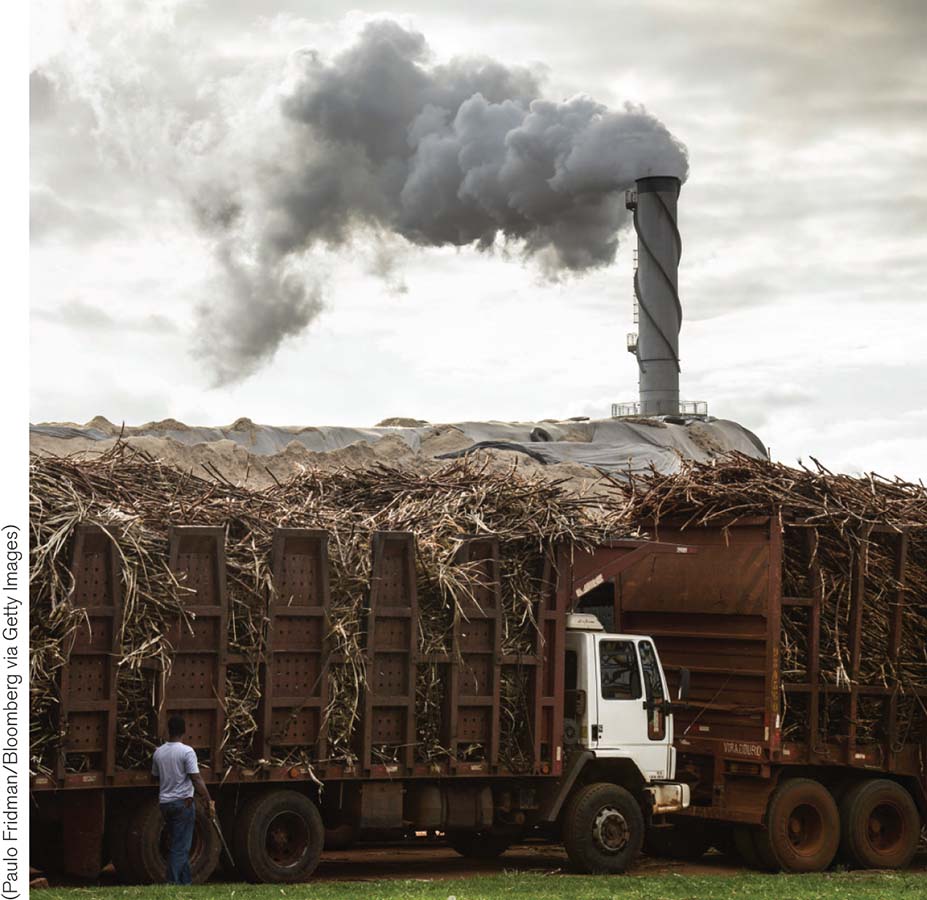10.3 Biomass fuels represent stored chemical energy

What factors contribute to the common use of biomass fuels today among the poor in developing countries?
biomass fuel A combustible fuel derived from biological materials (e.g., wood, charcoal, dung).
When you cook food over a campfire, you’re burning a biomass fuel, a combustible fuel derived from biological materials. Wood is certainly the most common biomass fuel used today, but it’s not the only one. In places without forests, local people have long burned dung from livestock and wild animals as fuel for cooking and for warmth (Figure 10.20). In addition, plant oils (e.g., olive oil) and animal fats (e.g., whale blubber) have also been used as sources of light and heat.

biofuel A liquid or gaseous fuel derived from biomass (e.g., ethanol, biodiesel).
Increasingly, biomass is becoming an important renewable source of fuel for transportation and for generating electricity. It may be used directly in relatively raw form, such as when wood is burned for heat, or it may be converted to a variety of liquid or gaseous fuels known as biofuels, the production of which has grown rapidly (Figure 10.21).

Biofuels from Plants
Ethanol, one of the common biofuels, is widely used as a gasoline additive. The process of manufacturing ethanol from grains, including corn, barley, and rice, has been known for thousands of years—

cellulosic ethanol Ethanol produced from wood and other cellulose-
Using whole plants to produce ethanol is more challenging. The process has been limited by the difficulty and cost of converting large cellulose molecules, the main chemical component of woody plant material, to simpler sugar molecules that are easily fermented to ethanol. These technical barriers are rapidly falling, however, in the face of intensive research and development. This research has provided the technical basis for opening commercial-

In addition to producing ethanol, used mainly as an additive to gasoline, several methods are under development to convert wood and other plant material into gasoline, diesel, and jet fuels, using genetically modified bacteria. One advantage of converting terrestrial plant biomass to these types of fuels is that they are more energy-
Biofuels from Algae
biodiesel A liquid fuel made from vegetable oils and animal fats.
Today, soybean oil, canola oil, and palm oil represent the primary source materials for the biofuel known as biodiesel, a fuel made from vegetable oils and animal fats. However, there are other sources of biodiesel under development. The algae that float in swimming pools, ponds, and the open ocean are remarkably efficient at capturing sunlight and turning it into the energy and materials they need for growth. Some algae can double in number in just 12 hours. Their exponential growth means that, compared with corn, they are able to produce at least 10 times more fuel in the same amount of time.
Moreover, they can also be grown in brackish waters and in marginal conditions that do not support food crops. Perhaps their best attribute is that they naturally produce and store oils that are similar to the vegetable oil you can buy at the grocery store. Oil can be more readily harvested and converted into fuels we already use, including biodiesel, gasoline, and even jet fuel. That’s one reason why the major oil companies—
Scientists are studying thousands of algal strains around the world to find those that grow the fastest and have the greatest potential for biofuel production. For instance, a group of researchers at the Scripps Institute of Oceanography have managed to genetically modify diatom algae to produce more oils than they normally would, without negatively affecting their growth. In 2009 Synthetic Genomics in La Jolla, California, which was founded by the human genome sequencing pioneer J. Craig Venter, received a $600 million commitment from ExxonMobil to build an algae biofuel plant. Nevertheless, substantial research and development will be required before algae-
Think About It
How are biomass fuels similar to fossil fuels? How are they different?
What were some of the first biofuels used by humans?
What are some advantages of biodiesel over ethanol?
10.1–10.3 Science: Summary
Renewable energy resources include solar, wind, water, and geothermal energy, along with biomass fuels. Solar energy can be used to generate electricity directly using photovoltaic cells or via concentrating solar power plants that run steam turbines. Other forms of renewable energy include hydropower dams, tidal power stations, and wind turbines that harness the kinetic and potential energy in the water or wind.
Wave generators are a new technology to capture wave energy in the oceans. Geothermal energy is heat energy produced in Earth’s core by nuclear fission. Biomass and biofuels provide sources of chemical energy, which will be critical for powering the transportation sector. Biofuels currently on the market include corn-